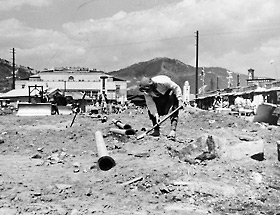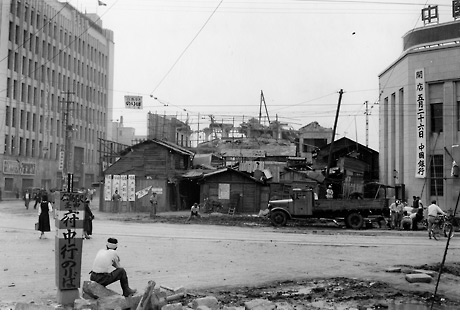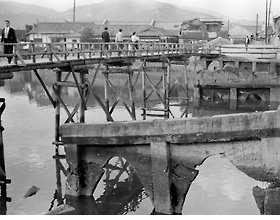Reconstructing the City
Construction Delay
The biggest challenge in the construction of Peace Memorial City was land readjustment. A drastic widening of old roads, and the construction of new ones, required the relocation of houses that stood on the planned construction sites. Little progress was being made in finding substitute lots for the landowners. The replotting project had a rough passage with problems such as residents who owned no land refusing to be evacuated. Sites that had been secured with great difficulty were replotted one by one. Paving work was delayed until later.
 |
 |
In front of Hiroshima Station after the fire
1949
Matsubara-cho
On March 27, 1949, a fire broke out in the public market in front of Hiroshima Station. In the city plan, this area was meant to become a green zone with a department store. However, less than one month after the fire, this area was built up with about 550 generic box-shaped stores.
|
 |
 |
 |
 |
 |
 |
|
Shacks remaining at Hatchobori Intersection
1953
Teppo-cho (now, Hatchobori)
View looking west from Hatchobori Intersection. Between the new wing of Fukuya Department Store on the left and Chugoku Bank on the right, the old wing of Fukuya Department Store in the demolition work and houses before the eviction appear. Relocation and eviction problems were major factors in delaying the construction work.
|
Aioi Dori after it rained
1954
Hatchobori (now, Ebisu-cho)
View looking west from the area in front of the new wing of Fukuya Department Store. The paving work was not completed all at once due to an eviction problem and the incomplete sewage system. It caused quick emergence of sloppy roads when it rained, which was a source of trouble for both pedestrians and drivers.
|
|
 |
 |
 |
Taisho Bridge
1954
Taisho Bridge across the Enkogawa River, located approximately 2,030 meters from the hypocenter, was damaged by the A-bombing. The bridge's girder was washed away in Makurazaki Typhoon the next month. The remaining part of the bridge was temporarily repaired by patching a makeshift wooden bridge. In 1958, full-fledged replacement was finally implemented.
|




